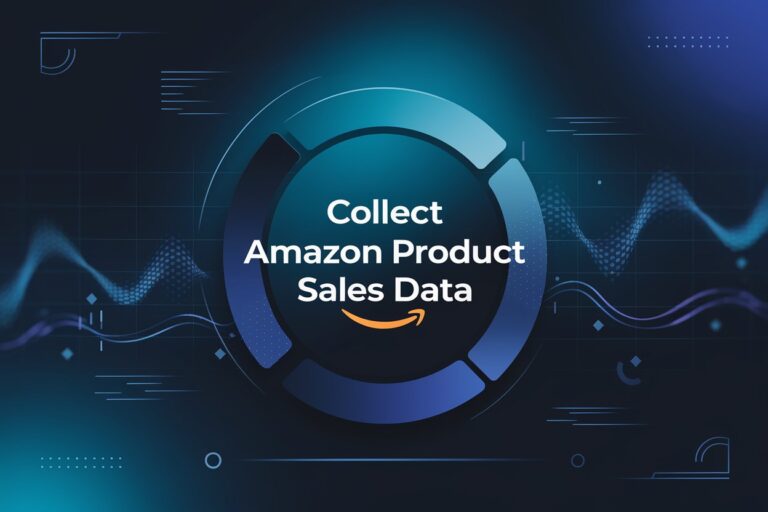In today’s highly competitive e-commerce market, obtaining accurate sales data is an essential tool for every seller and operator. Amazon sales data helps sellers understand market trends, optimize inventory, adjust pricing, and develop marketing strategies. However, the challenge lies in how to efficiently and seamlessly collect this data, especially for those without coding experience.
This article will dive into what Amazon sales data is and why it’s important, explore the common ways to collect this data, and focus on Amazon Data Pilot by Pangolin, a tool that allows you to easily collect Amazon sales data without any coding. By comparing traditional data collection methods, we will highlight the advantages of Pangolin’s approach and how it can help operators make precise decisions in a complex e-commerce environment.
What is Amazon Sales Data?
Amazon sales data refers to a product’s performance on the Amazon platform over a specific period, including sales volume, sales value, product rankings, reviews, ratings, and more. This data serves as an essential basis for strategic decisions made by e-commerce operators and sellers.
- Sales Volume: Reflects the number of units sold within a specific timeframe. Sales volume directly affects a product’s market performance and inventory management.
- Product Ranking: Amazon ranks products based on factors like sales volume, ratings, and price. Product ranking plays a significant role in influencing consumer buying decisions.
- Customer Reviews and Ratings: Consumer feedback and ratings directly influence a product’s sales potential.
- Competitor Data: Understanding competitors’ sales can help sellers make pricing decisions and adjust marketing plans.
By analyzing this data, sellers can identify shifts in market demand, optimize product positioning, create effective marketing strategies, and maximize sales.
Why Should You Collect Amazon Sales Data?
Collecting Amazon sales data is critical for sellers as it helps in making several informed decisions, including:
Analyzing Product Trends Using Sales Data
Sales data reflects how a product is performing in the market and reveals changes in consumer demand. Sellers can analyze sales fluctuations to predict which products will become top sellers and which products are seeing a decline in demand. For instance, certain product categories might see a spike in sales during holidays, allowing sellers to prepare their inventory accordingly.
Optimizing Inventory Management
Understanding which products are selling well and which ones are not helps sellers better manage their inventory. Through data analysis, sellers can reduce overstocking of slow-moving items, avoid excess inventory, and increase stock for popular products to ensure consumer demand is met.
Adjusting Pricing Strategies
Sales data also helps sellers formulate dynamic pricing strategies. If a product’s sales are falling, sellers may need to lower its price to attract consumers. Conversely, if sales are strong, sellers may choose to raise the price to increase profit margins.
Developing Effective Marketing Strategies
Sales data helps sellers analyze the effectiveness of their advertising campaigns. A sales boost may indicate successful ad campaigns, while a decline in sales could suggest that ad content, targeting, or budget needs to be adjusted. Data-driven decisions can help sellers achieve higher returns on ad spend (ROI).
Methods for Collecting Amazon Sales Data
Manual Queries
Manual querying is the most straightforward method where sellers visit Amazon’s website or backend to check the sales data of specific products. This method is suitable for querying individual products, but when handling large amounts of data, it becomes inefficient and subject to delays in data updates.
Limitations:
- Time-consuming: Manual queries require sellers to individually check each product’s data, which is slow and inefficient.
- No bulk processing: When handling many products, manual queries become cumbersome and prone to errors.
- Data Lag: Data gathered manually is often outdated, and may not reflect real-time market changes.
Using APIs to Collect Data
Using APIs to collect data is currently the most common method for automating the collection of sales data. Through APIs, sellers can collect precise and up-to-date data about products, including sales volume, pricing, reviews, and rankings. Common APIs include Amazon Scrape API and Amazon Data API.
Amazon Scrape API:
The Scrape API collects data by simulating user behavior and scraping product pages on Amazon. It is useful when large-scale data collection from multiple pages is required.
Advantages:
- Mass data scraping: Scrape API can collect large amounts of product sales data at once.
- Flexibility: You can choose the specific fields you want to collect, such as sales volume, pricing, ratings, etc.
Limitations:
- Anti-scraping mechanisms: Amazon has robust anti-scraping mechanisms, and using Scrape API may result in IP bans or failed data collection.
- Data inaccuracy: Since it simulates user behavior, the collected data may not always be accurate.
- Technical skills required: The use of Scrape API requires technical knowledge, and sellers may need to use proxies, VPNs, or other tools to bypass anti-scraping measures.
Amazon Data API:
Amazon’s official APIs (such as the Amazon Product Advertising API) allow developers to collect detailed product data, including sales volume, pricing, reviews, and rankings. Unlike Scrape API, the Data API provides data directly from Amazon’s system, making it more accurate and reliable.
Advantages:
- Data accuracy: Data collected through official APIs is generally more accurate compared to Scrape APIs.
- Stability: Data API is less affected by anti-scraping mechanisms and is more stable.
- Official support: The data collected through the Data API is provided directly by Amazon, ensuring its legality.
Limitations:
- Rate limits: Amazon Data API typically has usage limits, and frequent calls may result in restrictions.
- Technical expertise: API usage requires programming skills, which may require the assistance of developers for those without technical experience.
- Cost: Some APIs charge fees, especially for large-scale data collection.
Using Third-Party Tools
For sellers without programming experience, third-party tools offer a convenient way to collect Amazon sales data. For example, Amazon Data Pilot by Pangolin is a tool designed for non-technical users that allows easy collection of Amazon sales data.
Advantages:
- No coding required: Sellers without coding experience can easily collect sales data through a simple interface.
- Streamlined process: The user-friendly interface makes it easy to collect and analyze data quickly.
- Real-time updates: The data is regularly updated, ensuring that sellers receive the most accurate market insights.
Suitable Scenarios:
- Small to medium-sized businesses: Small-scale e-commerce sellers without technical backgrounds can quickly use Amazon Data Pilot to collect data.
- Operators needing fast decisions: Sellers who need to understand market trends quickly can use this tool to gather valuable data and make timely adjustments.
Advantages and Limitations of Different Data Collection Methods
Advantages and Challenges of Using APIs
APIs are an efficient method for collecting Amazon sales data, especially for those needing precise, real-time data. APIs allow for the automation of data collection across a wide range of products, significantly improving efficiency.
Advantages:
- Automation: APIs automate the collection of large amounts of data, reducing manual work and improving efficiency.
- Real-time updates: Data collected through APIs is usually up-to-date, reflecting the latest market trends.
- Flexibility: Sellers can customize the data collection to suit their needs.
Challenges:
- Technical requirements: Using APIs requires programming knowledge, which may require developers’ assistance for those without a technical background.
- Rate limits: API calls typically have usage limits, and excessive use may result in restrictions or extra charges.
Limitations of Data Scraping and API Collection
While scraping and API collection are common methods for gathering Amazon sales data, they both come with certain limitations. Amazon imposes strict restrictions on scraping and API calls, which can affect the stability and accuracy of data collection.
Limitations:
- Anti-scraping technologies: Amazon’s strong anti-scraping technologies may lead to IP bans or failed data scraping.
- Data instability: Scraping data may be less reliable due to the nature of simulated user behavior.
- API rate limitations: For sellers who need large-scale data, API usage limits can become a bottleneck.
Conclusion: How to Choose the Right Method for Collecting Amazon Sales Data?
Depending on your needs and technical background, you can choose the most suitable method for collecting Amazon sales data. If you’re a seller with no coding experience, Pangolin’s Amazon Data Pilot is a simple tool that enables you to easily collect data and make effective decisions. On the other hand, for sellers with programming knowledge, using Amazon Data API or Scrape API can provide more flexibility and precision in data collection.
Ultimately, sellers should select the tool or method that best fits their needs, resources, and technical capabilities to ensure they can collect and analyze sales data in real time, driving business growth.
Frequently Asked Questions (FAQ)
1. How can Amazon sales data help optimize inventory management?
By analyzing sales data, sellers can identify which products are selling well and which are not. This helps them adjust inventory levels, reduce overstock of slow-moving items, and ensure enough stock for high-demand products.
2. Do all sellers need to collect sales data?
For any seller wanting to succeed on Amazon, sales data is essential. It helps sellers understand market dynamics, adjust pricing and marketing strategies, and ultimately increase sales.
3. Do I have to pay to collect Amazon sales data?
Some APIs and third-party tools may charge fees,
particularly if you need to collect large amounts of data. Sellers can choose the right tool based on their needs, and some tools offer free trials.
4. Is Pangolin’s Amazon Data Pilot easy to use?
Absolutely! Pangolin’s Amazon Data Pilot is designed with simplicity in mind. Sellers without any coding experience can easily use it, and it only takes three simple steps to collect data.



